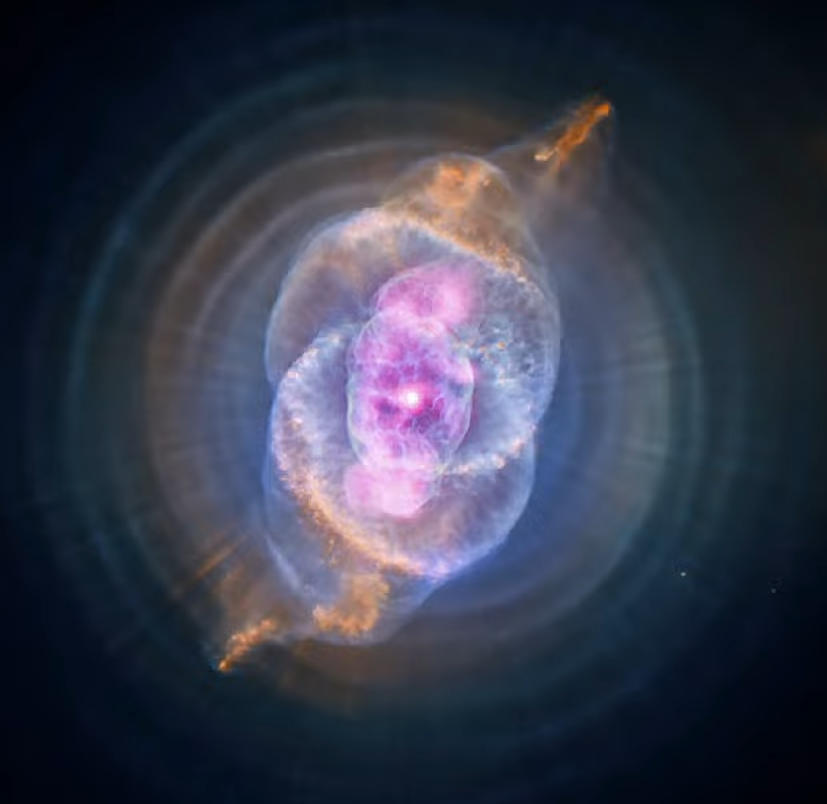

A Macskaszem-köd képe a Hubble Űrteleszkóp segítségével. Köszönetnyilvánítás: NASA/CXC/SAO/K.Arcand, SYSTEM Sounds (M. Russo, A. Santaguida)
A csillagászok szinte tökéletes szimmetriájú gyűrűket fedeznek fel a Macskaszem-ködben
A kutatók megépítették a Macskaszem-köd első számítógéppel generált 3D-s modelljét, amely egy pár szimmetrikus gyűrűt tár fel a köd külső héja körül. A gyűrűk szimmetriája arra utal, hogy a köd központi csillagából kiinduló sugársugár hozta létre őket. Ez erős bizonyítékot szolgáltat arra, hogy a köd közepén található kettős csillag. A tanulmány nemrég jelent meg a folyóiratban A Royal Astronomical Society havi közleményei Ryan Claremont vezette.
A bolygóköd akkor keletkezik, amikor egy haldokló csillag kilövi külső gázrétegét, létrehozva a bolygóködökre jellemző színes, kagylószerű szerkezetet. Az NGC 6543 vagy a Macskaszem-köd az egyik legösszetettebb ismert bolygóköd. Alig több mint 3000 fényévre van a Földtől, és a Draco csillagképben látható. A Macskaszem-ködöt is nagyon részletesen látta[{” attribute=””>Hubble Space Telescope, exhibiting a complicated structure of knots, spherical shells, and arc-like filaments.

A side-by-side comparison of the three-dimensional model of the Cat’s Eye Nebula created by Clairmont and the Cat’s Eye Nebula as photographed by the Hubble Space Telescope. Ryan Clairmont (left), NASA, ESA, HEIC, and The Hubble Heritage Team (STScI/AURA) (right) (CC BY-NC-SA 4.0).
The nebula’s mysterious structure confounded astrophysicists because it could not be explained by previously accepted theories for planetary nebula formation. More recent research showed that precessing jets were potential shaping mechanisms in complex planetary nebulae such as NGC 6543, but lacked a detailed model.
Clairmont, an astronomy enthusiast, decided to try to establish the detailed 3D structure of the Cat’s Eye to find out more about the potential mechanism that gave it its intricate shape. To do this, he sought out the help of Dr. Wolfgang Steffen of The National Autonomous University of Mexico and Nico Koning from the University of Calgary, who developed SHAPE, 3D astrophysical modeling software particularly suitable for planetary nebulae.
The researchers used spectral data from the San Pedro Martir National Observatory in Mexico to reconstruct the nebula’s three-dimensional structure’s three-dimensional structure. These provide detailed information on the internal motion of material in the nebula. Together with these data and images from the Hubble Space Telescope, Clairmont constructed a novel 3D model, establishing that rings of high-density gas were wrapped around the outer shell of the Cat’s Eye. Surprisingly, the rings are almost perfectly symmetric to each other, suggesting they were formed by a jet – a stream of high-density gas ejected in opposite directions from the nebula’s central star.
The jet exhibited precession, similar to the wobbling motion of a spinning top. As the jet wobbled, or precessed, it outlined a circle, creating the rings around the Cat’s Eye. However, the data indicates the rings are only partial, meaning the precessing jet never completed a full 360-degree rotation, and that the emergence of the jets was only a short-lived phenomenon. The duration of outflows is an important piece of information for the theory of planetary nebulae. Since only binary stars can power a precessing jet in a planetary nebula, the team’s findings are strong evidence that a system of this type exists at the center of the Cat’s Eye.
As the angle and direction of the jet changed over time, it likely formed all of the features seen in the Cat’s Eye, including the jets and knots. Using the three-dimensional model, the researchers were able to calculate the tilt and opening angle of the precessing jet based on the orientation of the rings.
Ryan Clairmont, the lead author of the paper and now a prospective undergraduate at Stanford University stated, “When I first saw the Cat’s Eye Nebula, it was astonishing. It had a beautiful, perfectly symmetric structure. I was even more surprised that its 3D structure was not fully understood.”
He continued, “It was very rewarding to be able to do astrophysical research of my own that actually has an impact in the field. Precessing jets in planetary nebulae are relatively rare, so it’s important to understand how they contribute to the shaping of more complex systems like the Cat’s Eye. Ultimately, understanding how they form provides insight into the eventual fate of our Sun, which will itself one day become a planetary nebula.”
Reference: “Morphokinematic modelling of the point-symmetric Cat’s Eye, NGC 6543: Ring-like remnants of a precessing jet” by Ryan Clairmont, Wolfgang Steffen and Nico Koning, 15 September 2022, Monthly Notices of the Royal Astronomical Society.
DOI: 10.1093/mnras/stac2375

„Utazási specialista. Tipikus közösségi média tudós. Az állatok barátja mindenhol. Szabadúszó zombinindzsa. Twitter-barát.”





More Stories
A SpaceX Polaris Dawn űrszondájának legénysége a valaha volt legveszélyesebb űrsétára készül
Egy őskori tengeri tehenet evett meg egy krokodil és egy cápa a kövületek szerint
Egyforma dinoszaurusz-lábnyomokat fedeztek fel két kontinensen